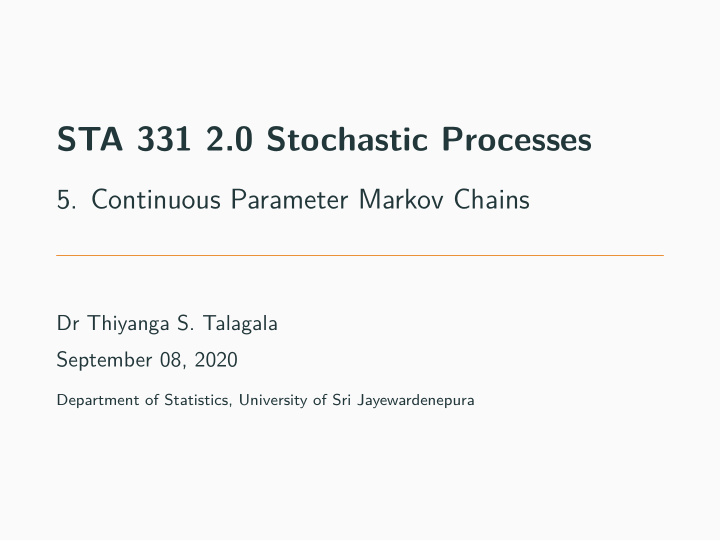



STA 331 2.0 Stochastic Processes 5. Continuous Parameter Markov Chains Dr Thiyanga S. Talagala September 08, 2020 Department of Statistics, University of Sri Jayewardenepura
Goals 1. Explain the Markov property in the continuous-time stochastic processes. 2. Explain the difgerence between continuous time and discrete time Markov chains. 3. Learn how to apply continuous Markov chains for modelling stochastic processes. 2
Stochastic Processes parameter = time source: https://towardsdatascience.com/ 3
Continuous Parameter Markov Chains Suppose that we have a continuous-time taking on values in the set of nonnegative integers. The 4 (continuous-parameter) stochastic process { N ( t ); t ≥ 0 } process { N ( t ); t ≥ 0 } is called a continuous parameter Markov chain if for all u , v , w > 0 such that 0 ≤ u < v and nonnegative integers i , j , k , P [ N ( v + w ) = k | N ( v ) = j , N ( u ) = i , 0 ≤ u < v ] = P [ N ( v + w ) = k | N ( v ) = j ] .
Continuous Parameter Markov Chains (cont.) In other words, a continuous-time Markov chain is a stochastic process having the Markovian property that the conditional independent of the past. If, in addition, is independent of v , then the continuous parameter Markov chain is said to have stationary or homogeneous transition probabilities . 5 distribution of the future N ( v + w ) given the present N ( v ) and the past N ( u ) , 0 ≤ u < s , depends only on the present and is P [ N ( v + w ) = k | N ( v ) = j ]
Discrete Time versus Continuous Time (In class) diagram DTMC: Jump at discrete times: 1, 2, 3, … 6 CTMC: Jump can occur at any time t ≥ 0.
Transition Probabilities Recap: P n Transition probability of continuous Markov chains • If the transition probabilities do not explicitly depend on s or t but only depend on the length of the time interval • Otherwise, they are nonstationary or nonhomogeneous. • We’ll assume the transition probabilities are stationary (unless stated otherwise). 7 ij - transition probability of discrete Markov chains p ij ( t , s ) = P [ N ( t ) = j | N ( s ) = i ] , s < t . t − s , they are called stationary or homogeneous .
Homogeneous transition probabilities state j will be in start k a time w later. 8 p jk ( w ) = P [ N ( v + w ) = k | N ( v ) = j ] p jk ( w ) represents the probability that the process presently in
Poisson Process k=1 stationary increments. • The third condition implies that the process has 9 2. The process has independent increments, Let N ( t ) be the total number of events that have occurred up to time t . Then, the stochastic process { N ( t ); t ≥ 0 } is said to be a Poisson process with rate λ if 1. N ( 0 ) = 0, 3. For any t ≥ 0 and h → 0 + , λ h + o ( h ) , P [ N ( t + h ) − N ( t ) = k ] = o ( h ) , k ≥ 2 1 − λ h + o ( h ) , k = 0 f ( h ) • The function f ( . ) is said to be o ( h ) if lim h → 0 h = 0 .
Theorem 10 Suppose { N ( t ); t ≥ 0 } is a Poisson process with rate λ . Then { N ( t ); t ≥ 0 } is a Markov process.
Theorem Then, the number of events in any interval of length t has a 11 Suppose that { N ( t ); t ≥ 0 } is a Poisson process with rate λ . Poisson distribution with mean λ t . That is for all s , t ≥ 0, P [ N ( t + s ) − N ( s ) = n ] = e − λ t ( λ t ) n n ! For a Poisson process with rate λ , the transition probability p ij ( t ) is given by p ij ( t ) = e − λ t ( λ t ) j − i ( j − i )!
Acknowledgement The contents in the slides are mainly based on Introduction to Probability Models by Sheldon M. Ross. 12
Recommend
More recommend